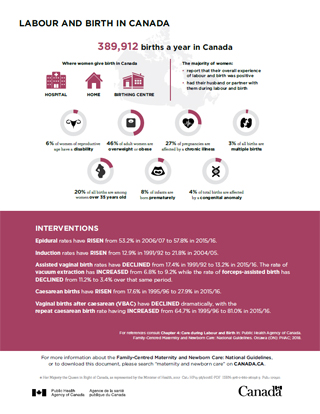Chapter 4 Infographic: Labour and birth in Canada

Download in PDF format
(162 KB, 1 pages)
Organization: Public Health Agency of Canada
Published: 2018-06-20
389,912 births a year in Canada
Where women give birth in Canada
- Hospital
- Home
- Birthing Centre
The majority of women
- report that their overall experience of labour and birth was positive
- had their husband or partner with them during labour and birth
- 6% of women of reproductive age have a disability
- 46% of adult women are overweight or obese
- 27% of pregnancies are affected by a chronic illness
- 3% of all births are multiple births
- 20% of all births are among women over 35 years old
- 8% of infants are born prematurely
- 4% of total births are affected by a congenital anomaly
Interventions
- Epidural rates have risen from 53.2% in 2006/07 to 57.8% in 2015/16.
- Induction rates have risen from 12.9% in 1991/92 to 21.8% in 2004/05.
- Assisted vaginal birth rates have declined from 17.4% in 1991/92 to 13.2% in 2015/16. The rate of vacuum extraction has increased from 6.8% to 9.2% while the rate of forceps-assisted birth has declined from 11.2% to 3.4% over that same period.
- Caesarean births have risen from 17.6% in 1995/96 to 27.9% in 2015/16.
- Vaginal births after caesarean (VBAC) have declined dramatically, with the repeat caesarean birth rate having increased from 64.7% in 1995/96 to 81.0% in 2015/16.
For references consult Chapter 4: Care during Labour and Birth in: Public Health Agency of Canada. Family-Centred Maternity and Newborn Care: National Guidelines. Ottawa (ON): PHAC; 2018.
Page details
- Date modified: